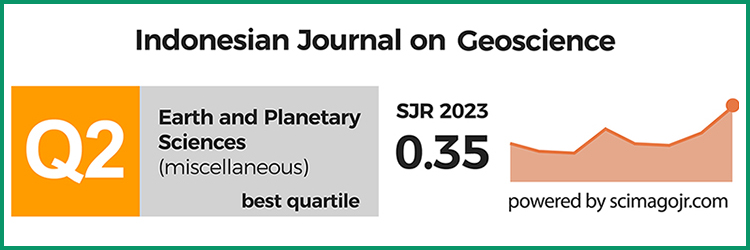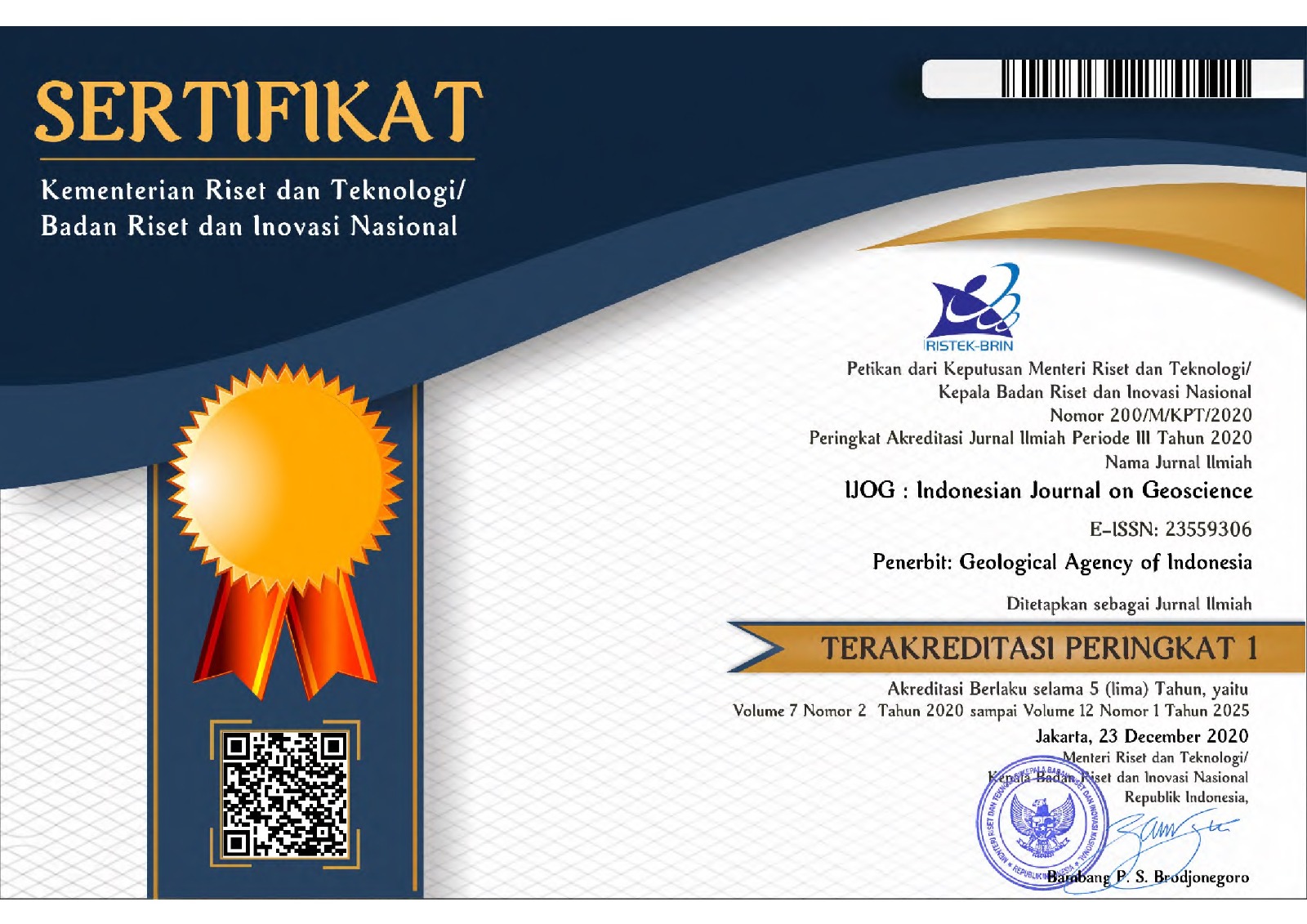Ore-Forming Fluids of Orogenic Gold Deposit In Tamilouw-Haya, Seram Island, Indonesia
DOI:
https://doi.org/10.17014/ijog.10.3.363-377Keywords:
Orogenic gold, fluid inclusion, microthermometry, ore-forming fluidsAbstract
The Tamilouw-Haya orogenic gold deposit is located in the southern arm of Seram Island, Indonesia, occupying Tehoru Metamorphic Complex. Gold mineralization is predominantly in the form of veins, stockwork, and breccia, although minor dissemination is slightly appeared in the rock float samples. Ore-mineral assemblages are dominated by native gold, pyrite, chalcopyrite, sphalerite, tetrahedrite-tennantite (sulfosalt), galena, pyrrhotite, marcasite, realgar, kalininite, and arsenopyrite. Covellite, hematite, goethite, and malachite appear as supergene minerals. High-grade gold ores in this area are generally found in quartz-carbonate veins with the main alteration processes involving silicification, carbonatization, and sericitic. The P-T history of the mineralization was revealed by fluid inclusions, and this study implies the depth of ore deposit and its evolution during mineralization. The primary fluid inclusions from three different types of quartz/quartz-carbonate veins in Tamilouw-Haya crystallized at the homogenization temperature (Th) of 240 °C to 340 °C, with a fluid salinity from 3.87 to 0.70 wt. % NaCl equivalent, and melting temperature (Tm) of -0.4 to -2.3 oC. The ore-forming fluids consist mainly of two-phase (VCO2+LH2O) liquid-rich aqueous inclusions, characterized by low to rich CO2, low salinity, and moderate temperature. There are three vein types as the ore-bearing fluids with precious metals and anomalous high basemetal contents. Quartz type 1- veins (V1); concordant veins, formed at a temperature of 240-307 oC with an average salinity of 1.8 wt. % NaCl equivalent. Quartz type 2- veins (V2) tend to cut the rock foliation which are formed at temperature range from 293-336 oC with the average salinity that shows a value of 2.4 wt. % NaCl equivalent. Meanwhile, type 3 quartz-carbonate veins (V3) are formed at the temperature range of 240-340 oC and the average salinity of 2.72 wt. % NaCl equivalent. These quartz-carbonate veins cut the wall-rock foliation, which is identified as the late stage and associated with ore deposition in Tamilouw-Haya. The gold deposit in Tamilouw-Haya is formed at a depth of about 5.5-9 km of paleosurface, and the pressure between 1.7-2.4 Kbar in epizonal to mesozonal zones.
Keywords: Tamilouw-Haya, orogenic gold, fluid inclusion, microthermometry, ore-forming fluids
References
Anonymous., 2015. Buku potensi Sumber Daya Mineral Logam dan Non logam, provinsi Maluku, Dinas Energi dan Sumber Daya Mineral Provinsi Maluku.
Audley-Charles, M.G., Carter, D.J., Barber, A.J., Norvick, M.S., Tjokrosapoetro, S., 1979. Re-interpretation of the Geology of Seram : Implications for the Banda Arcs and Northern Australia. J. geol. Soc.London,136, 547-568.
Bodnar, R.J.,Vityk, M.O., 1994. Interpretation of Microthermometric Data for H2O-NaCl Fluid Inclusions. In. De Vivo, B. and Frezzotti, M.L. (Eds.). Fluid Inclusions in Mineral, Methods and Applications, Published by Virginia Tech, Blacksburg, VA.
Bodnar, R.J., 1993. Revised Equation and Table for Determining the Freezing Point Depression of H2O-NaCl Solution. Geochimica Et Cosmochimica Acta, 57, 683-684.
Brown, P.E., Hagemann, S.G., 1995. MacFlincor and its application to fluids in Archean lode gold Deposits. Geochimica et Cosmochima Acta, 59, 3943–3952.
Cooke, D.R., Simmons, S.F., 2000. Characteristics and genesis of epithermal gold deposits. Reviews in Economic Geology , 13, 221–244.
Corbett, G.J., Leach, T.M., 1998. Southwest Pacific Rim gold-copper systems: Structure, alteration and mineralization. Society of Economic Geologists Special Publication, 6, 240.
Franklin, Moe’tamar, Reza, M., 2013. Inventarisasi endapan logam di Kabupaten Seram Bagian Barat Provinsi Maluku. Laporan internal. Tidak dipublikasikan. Pusat Sumber Daya Geologi, Bandung.
Gebre-Mariam, M., Hagemann, S.G., Groves, D.I., 1995. A classification scheme for epigenetic Archaean lode-gold deposits. Miner Deposita, 30, 408–410.
Gemmell, J.B., Simmons, S.F., 2007. A Group of Papers Devoted to Epithermal Au-Ag Deposits: Preface. Economic Geology, 102 (5), 783
Goldfarb, R.J., Groves D.I., Gardoll, S.,2001.Orogenic gold and geologic time: a global synthesis. Ore Geology Review, 18, 1–75.
Groves, D.I.,1993. The crustal continuum model for late-Archean lode gold deposits of the Yilgarn block, Western Australia. Mineral Deposits, 28, 366–374.
Groves, D.I., Goldfarb, R.J., Gebre M.M., Hageman.S.G., Robert.F., 1998. Orogenic gold deposit ; A proposed classification in the context of their crustal distribution and relationship to other gold deposits types. Ore Geology Review,13, 7-27.
Hasria., 2018. Karakteristik mineralisasi emas hidrotermal yang berasosiasi dengan batuan metamorf di pegunungan mendoke dan rumbia pada lengan tenggara pulau sulawesi, Indonesia. PhD thesis. Universitas Gadjah Mada, Yogyakarta.
Idrus, A., Prihatmoko, S., 2011. The metamorphic rock-hosted gold mineralization at Bombana, Southeast Sulawesi: A new exploration target in Indonesia, Proceedings of The Sulawesi Mineral Seminar, 28–29 Nov 2011, Manado, North Sulawesi, Indonesia, 243-258.
Idrus, A., Prihatmoko, S., Hartono, H.G., Idrus, F., Ernowo., Franklin., Moetamar., Setiawan, I., 2014. Some Key Features and Possible Origin of the Metamorphic Rock-Hosted Gold Mineralization in Buru Island, Indonesia, Indonesian Journal on geoscience,1, 9-19.
Kemp, G., Mogg, W., 1992. A re-appraisal of the geology, tectonics and prospectivity of Seram Island, Eastern Indonesia. Proceedings of Indonesian Petroleum Association 21st Annual Convention, 521–552.
Powell, D.E., 1976. The geological evolution of the continental margin of Northwest Australia. Journal of Australian Petroleum Exploration Association, 10, 13-23.
Pownall, J.M., Hall, R., Watkinson, I.M., 2013. Extreme extension across Seram and Ambon, eastern Indonesia : evidence for Banda slab rollback. Solid Earth, 4, 277–314.
Querubin, C. D., Walters, S., 2011. Geology and mineralization of Awak mas: A sedimentary hosted gold deposit, South Sulawesi, Indonesia. Proceedings of The Sulawesi Mineral Seminar, 28–29 Nov 2011, Manado, North Sulawesi, Indonesia, 211–222.
Roedder, E., 1984. Fluid inclusions, Mineralogical Society of America, Review in Mineralogy 12, 646.
Setyawan, B.W., Wijaya, B., Guntoro, A., 2000. Mengurai Perkembangan Tektonik Pulau Seram dan Ambon. Prosiding IAGI 29th Annual Convention, 4,33-45.
Shepherd, T.J., Rankin, A.H., Alderton, D.H.M., 1985. A Practical Guide to Fluid Inclusion Studies: Blackie and Son Ltd., Glasgow, 239p.
Tjokrosapoetro, S., Budhitrisna, T., 1982. Geology and tectonics of the northern Banda Arc. Bulletin of the Indonesian Geological Research and Development Centre, 6, 1–17.
Tjokrosapoetro, S., Rusmana, E.,Achdan, A., 1993. Geological Map of Ambon Quadrangle, Maluku, scale 1:250.000. Geological Research and Development Centre, Bandung.
Veevers, J.J., 1982. Western and northwestern margins of Australia. In: Nairn, A.E.M., Stehli, F., Oceanic Basin, 513-544.
Wajdi, M. F., Santoso, S. B., Kusumanto, D., Digdowirogo, S., 2011. Metamorphic hosted low sulphidation epithermal gold system at Poboya, Central Sulawesi: a general descriptive review. Proceedings of The Sulawesi Mineral Seminar, 28–29 Nov 2011, Manado, North Sulawesi, Indonesia, 201–210.
White, N.C., Hedenquist, J.W., 1995. Epithermal gold deposits: Styles, characteristics and exploration. SEG Newsletter, 23 (1), 9–13.
Wilkinson, J.J., 2001. Fluid Inclusions in Hydrothermal Ore Deposits. Lithos, 55, 229-272.



















